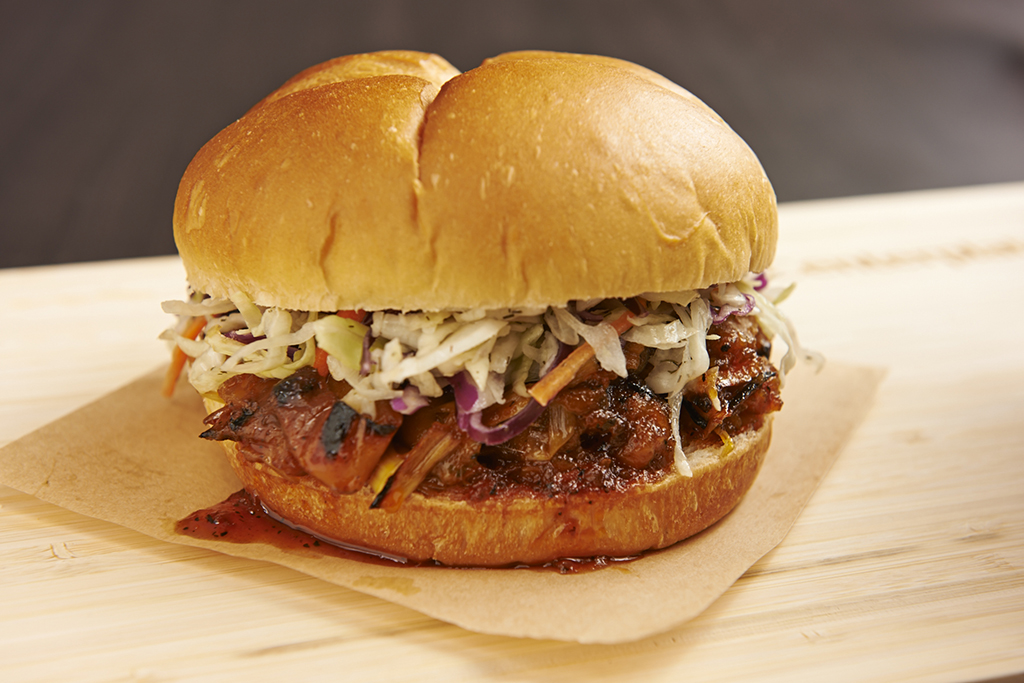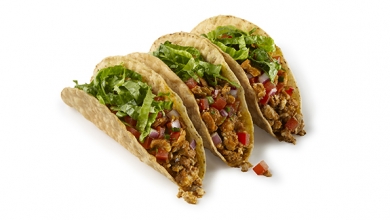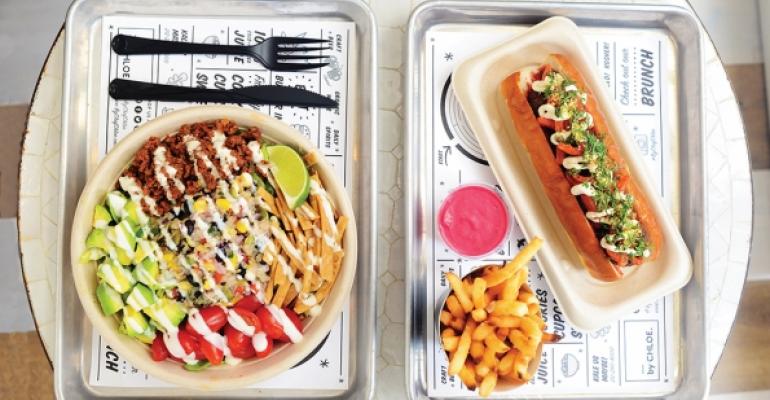NRN senior food editor Bret Thorn says National Food Days are out of control.

Bret Thorn
You know what I’d like to see, Nancy? A tray loaded with food that looks like crudités, but is actually made of meat: Bologna rolled up and coated in green aspic to resemble asparagus; chicken liver mousse piped into the shape of carrots, maybe with a glaze of orange-colored schmaltz; pancetta crisps curled up to look like radicchio.
It would make as much sense as nuts that are ground up, processed and pressed to look like cheese; or batter-fried tempeh coated in Buffalo sauce that consumers are expected to believe tastes like chicken; or beans and grains that are shaped into a patty and put on a bun with pickles, lettuce and tomato.
I love vegetables, Nancy, and I eat a lot of meatless meals. They can be nutritious, inexpensive, convenient (lentils cook in 20 minutes) and, because I know how to cook, they taste good.
I also like cheese, Buffalo wings and burgers. And guess what? I can easily tell the difference between cheese and nuts, and between chicken and processed soy. I bet most consumers can, too.
Nonetheless, I’m seeing a proliferation of plant-based proteins disguised as meat and cheese, as I’m sure you have, too, Nancy.
Chains including Tropical Smoothie Café and Which Wich Superior Sandwiches have introduced Beyond Meat Chicken-Free Strips in recent years (2013 and 2015, respectively), made mostly with a blend of soy and pea protein. Chipotle Mexican Grill has developed proprietary Sofritas, made from organic tofu, which it rolled out nationwide in 2014. Pancheros Mexican Grill, a 70-unit chain based in Coralville, Iowa, followed suit this year with Tofusada, its own tofu product that it made available systemwide in November.
Meanwhile, producer Beyond Meat has used mostly pea protein to make its Beyond Burger, which is colored with beets so it appears to “bleed.” Newer to the scene is Impossible Foods’ Impossible Burger, made with wheat protein, potato protein, coconut oil, carbohydrates from a Japanese yam, xanthan gum and heme.

This sandwich features tropical jackfruit, which is becoming increasingly popular as a meat substitute. It’s smoked, then braised, tossed in house barbecue sauce and served on a sweet Hawaiian roll with apple-jalapeño coleslaw. Photo: Centerplate
Heme is a protein found in all living cells, according to Impossible Foods founder Patrick Brown, but especially in the red blood cells of animals where it carries oxygen. The Impossible Burger gets its heme from plant sources, so Brown says it’s vegan.
Then there’s the producer Kite Hill, which has figured out how to catalyze almond milk to behave like dairy milk and curdle into something resembling cheese.
I’ve tried a lot of these foods, as well as unripe jackfruit disguised as meat. Jackfruit doesn’t have much protein, so I put it in a different category than plant-based protein. But in some of the formulations I’ve tried, it really does have the texture of stewed meat. (It still tastes like jackfruit, though.)
Also, tempeh tastes like tempeh. Tofu tastes like tofu. Beyond Meat’s chicken-free strips do not taste like chicken. The Impossible Burger has a texture sort of mushy, ground beef, and the iteration I tried tasted like toasted grain.
The Kite Hill product I sampled a couple of years ago looked like Brie and tasted buttery, but not like cheese.
On one level, I understand the impulse for plant-based meat and dairy substitutes. Meat is arguably a strain on the environment, and some people object to eating meat on moral grounds, but they still like its taste.
Nonetheless, Nancy, as you noted during your State of the Plate presentation at the MUFSO conference in October, vegetarians still only make up about 5 percent of the population. So why is all of this effort and capital going into what remains a niche market, and do you think anyone will ever succeed in making meat from plants?
Despite consumer awareness, meat is still the star

Nancy Kruse
Kruse Company president Nancy Kruse responds to NRN senior food editor Bret Thorn’s take on national food days.
I’ve started unsuccessfully to respond to you a couple of times, Bret, but I can’t seem to get past the images of baloney in green aspic and orange-colored schmaltz.
Happily I took a deep breath and persevered, because despite the unappetizing images, you raise some good questions.
First, I concur that there has been a dramatic uptick in the amount of R&D creativity and capital expended on developing plant-based foods. This represents, I think, the convergence of several powerful factors, beginning with the Pollanization of many consumers.
I’m referring to Michael Pollan, who in 2006 published “The Omnivore’s Dilemma,” an influential screed in which he took to task what he termed our industrialized food chain and called out transgressors like modern agribusiness and fast-food chains. In his subsequent publications and TED talks, Pollan has consistently repeated his dictum to “Eat food. Not too much. Mostly plants,” which has become a rallying cry for his adherents.
Then, in 2012, the Culinary Institute of America teamed up with Harvard’s T.H. Chan School of Public Health to launch the annual Menus of Change conference, which addresses the need to feed a burgeoning world population, emphasizes a plant-based diet as the means to do so and advocates for, among other things, The Protein Flip.
The Protein Flip suggests that instead of feeding plants and grains to animals, feed them directly to diners and provide much smaller amounts of animal protein, which the program says currently accounts for 85 percent of the protein we consume. The objective is to convince chefs to flip the amount of animal proteins and plants they put on the plate.
Inevitably, Millennials are a factor here, too, and this time they’re abetted by the even younger Generation Z. Many members of both age groups reside on college campuses, and campus dining halls have historically been a fertile breeding ground for vegetarians, vegans and food activists of all stripes.
I recall a few years ago that the dining director at a large public university told me that 20 percent of his student diners identified as vegetarians, a percentage that is four times greater than the population as a whole. Obviously, most don’t stick with the diet after graduation, but they can be passionate advocates while they do.
There’s also the media cachet of chefs like Chloe Coscarelli, who wowed judges on the Food Network’s Cupcake Wars TV competition with her vegan cupcakes. A Millennial herself, she garnered a first-place win that led to cookbooks and other television appearances.

Chipotle Mexican Grill began offering vegan tofu-based sofritas in October 2014. Photo: Chipotle
In 2015, Coscarelli opened By Chloe, a vegan restaurant in New York City, with business partner Samantha Wasser of ESquared Hospitality. Earlier this year, she signed a deal to franchise the concept in Whole Foods’ new 365 supermarkets.
This potent confluence of culinary thought leaders, TV and digital media influencers, and life-stage beliefs and behaviors largely explains the phenomenon. But I don’t think that animal-protein producers have done themselves any favors in this regard.
Slow to react to the growing clamor for plant-based alternatives, they’ve been lamentably slower to communicate initiatives they’ve undertaken in areas of sustainability and conservation. Maybe they’ve been lulled by research from The NPD Group showing that more than 50 percent of consumers regard meat as the best source of protein, with over 60 percent eating it on any given day.
The booming business in better burgers and fried-chicken sandwiches underscores that we’re a nation of carnivores, but there’s a new generation of consumers looking for an excuse to feel good about eating meat, and producers need to get busy and give them one. If they have a compelling story to tell, now is definitely the time to tell it.
Your closing question is much tougher to tackle, Bret. Surprisingly, I wouldn’t bet against someone making palatable meat substitute from plants. I mean, 10 years ago, I couldn’t have imagined ordering and paying for my favorite pizza by simply pushing a button on my phone, so anything is possible, right?
But I agree that the current crop of meat wannabes leaves much to be desired, especially with regard to texture. I’ve had the storied House-Made Veggie Burger at Houston’s Restaurants a couple of times. Considered best in class by meatless-burger connoisseurs, the patty is made of black beans and rice, among other ingredients, served with a sweet soy glaze, melted cheese and impeccably fresh lettuce and tomato on a first-rate bun. Once you’ve smothered it with your condiments of choice, it’s a truly tasty sandwich, but it’s just not a burger.
There’s one last thing, Bret. Like you, I’m an indiscriminate vegetable lover and avidly consume them all, with the exception of green bell pepper. So I wonder why most chefs generally do such a lousy job with them.
Institutional and commoditized, vegetables are often just tossed on the plate. The assumption seems to be that meat is the star of the show, and while this may often be the case, great vegetables can, I believe, become a real customer draw, a signature offering and a promotional opportunity.
Rather than try to make them into something they’re not, like “meatballs” and “wings,” I wish chefs would concentrate on making the best darn vegetables that they can.
Contact Bret Thorn at [email protected]
Follow him on Twitter: @foodwriterdiary
Nancy Kruse, president of The Kruse Company, is a menu trends analyst based in Atlanta and a regular contributor to Nation’s Restaurant News. E-mail her at [email protected].
Correction: Dec. 19, 2016 An earlier version of this story misstated the number of Pancheros Mexican Grill restaurants. There are 70.

